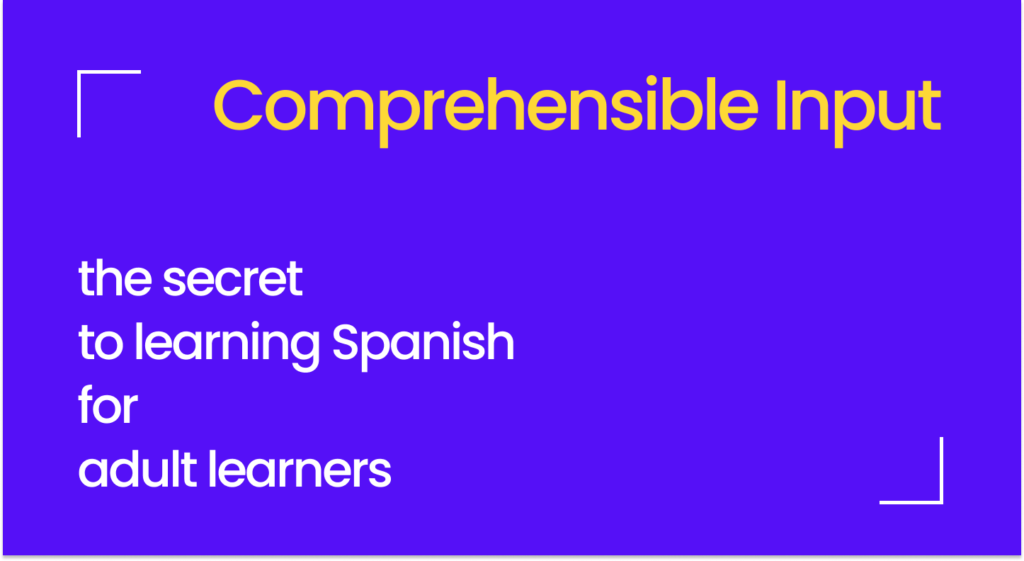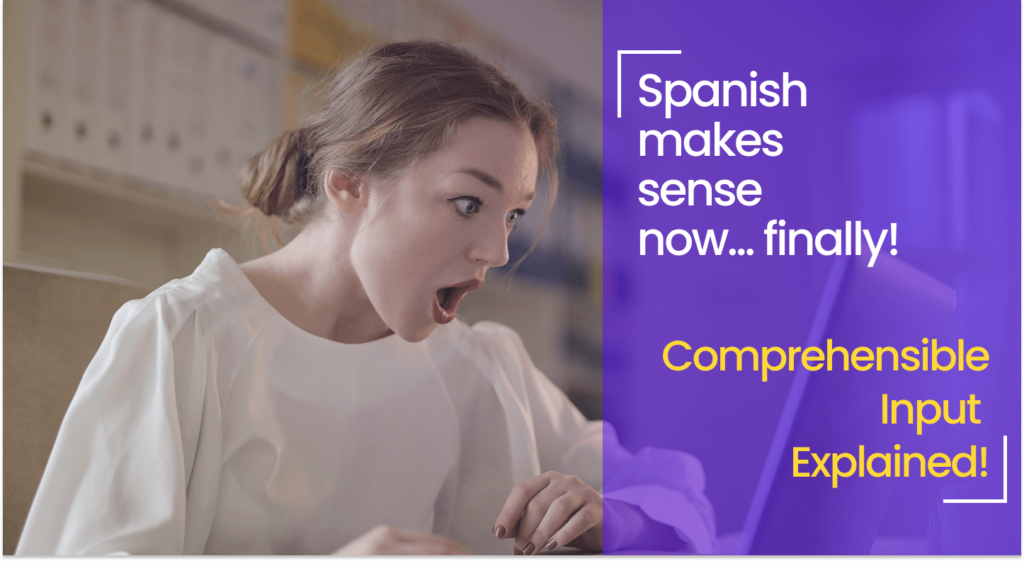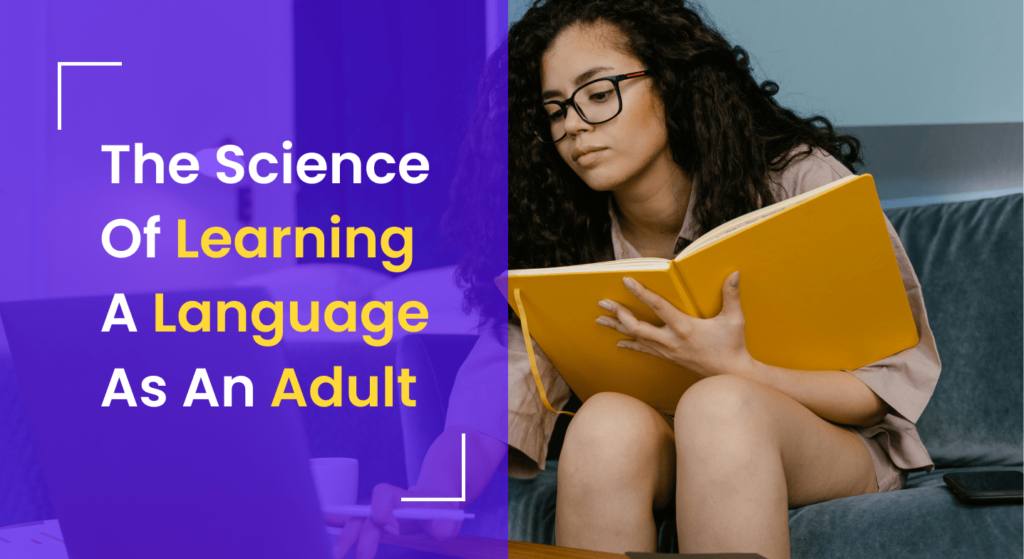Growing up in the Philippines, it’s pretty normal for someone to speak three languages — a local dialect, Filipino (our national language), and English as our second language. Of course, Filipino and English were taught as school subjects, but I mostly learned them at home. So as a kid, I was exposed to these languages every day, and over time, I just started speaking them naturally.
So when I moved to Madrid and couldn’t speak Spanish, I thought I could do the same thing — just immerse myself in Spanish materials and eventually I´ll start speaking it. Nope! That wasn’t the case. No matter how much Spanish I listened to, read, or watched, I still couldn’t understand much. Something was missing.
That missing formula turned out to be Comprehensible Input — a concept that completely changed how I approached learning Spanish. It was an awakening for me, and it helped me make real progress. And honestly, that’s one of the main reasons I passed my DELE A2 exam with high scores in listening and reading.
I intended to write this article for adults learning Spanish, especially those at a high A2 to B1 level, who feel stuck even after studying for a while. I hope what I discovered will help you as much as it helped me.
What Is Comprehensible Input?

The idea of comprehensible input was first proposed by linguist Stephen Krashen, who believed that we acquire language when we understand messages — not when we memorize grammar rules.
The keyword here is comprehensible. For input to work, you need to understand what’s being said, at least most of it. That doesn’t mean you have to know every single word — but you should be able to grasp the message. No matter how many times you’re exposed to the same word or phrase, if your brain doesn’t understand its meaning, it won’t stick.
When I first heard about this concept, I thought, “Well, that’s just common sense. The only way to learn something is to understand it.” But as I kept learning Spanish, and little by little, I began to realize just how powerful comprehensible input really is — especially for beginners and intermediate adult learners.
Let me explain this further in the next section.
My Eureka Moment Using Comprehensible Input
Here’s where it finally clicked for me:
Sometimes Spanish phrases translate perfectly into English. But other times, when you try to translate them word for word, they make zero sense. And when something doesn’t make sense, your brain struggles to learn it.
Let me illustrate it for you…
Beginner Level
Buenos días → Good morning
Straightforward, right? Buenos means “good,” and días means “days.” Your brain gets it instantly.
Intermediate Level
Me cae bien → I like him/her (as a person, not romantically)
When I first came across this phrase, I was completely confused. The material I was using simply said “me cae bien” means “I like him/her (as a person, not romantically).” But I couldn’t memorize it or use it naturally because it didn’t make sense in my head.
Later on, I learned that cae comes from the verb caer, which means to fall. So literally, me cae bien translates to “he/she falls well to me.” It’s how Spanish speakers express that they like someone’s personality or vibe.
And for some reason, once I understood that logic, it finally stuck. That’s comprehensible input in action — it’s not just exposure, it’s understanding with meaning.
Why Comprehensible Input Matters
As an intermediate Spanish learner, you’ll constantly face two types of phrases:
- Those you can translate word-for-word and instantly understand.
- Those that make no sense unless you find a way to explain them to your English-speaking brain.
It’s that second type — the confusing, doesn’t-make-sense ones — that help you grow the most. Because when you finally understand why they’re used that way, your brain forms a deeper connection. You stop memorizing and start acquiring.
This was a beginner mistake for me in my language-learning journey. When I started I thought I would be achieving Spanish fluency by learning the grammar rules, translating from English to Spanish, and voilà, I’d eventually become fluent. ¡Nope! That was not the case. Because the way Spanish speakers express their thoughts is often very different from how we do it in English.
As an intermediate learner, I started noticing that many everyday expressions don’t translate literally — and that’s exactly where comprehensible input becomes powerful.
More Spanish Examples That Made Me Go “Wait, What?”
|
Spanish Phrase |
How My Brain Understands It |
What It Really Means |
|---|---|---|
|
¿Cuánto te quedan? |
How much to you remain? |
How much do you have left? |
|
¿Te va? |
Does it go to you? |
Does that work for you? / Are you okay with that? |
|
Se me ha caído. |
It has fallen to me. |
I dropped it. |
|
Me da susto. |
It gives me fright. |
It scares me. |
|
Tengo pereza. |
I have laziness. |
I feel lazy. / I don’t feel like doing it. |
Once I understood the logic behind phrases like these, I stopped trying to “translate” everything and started to understand them for what they meant. And that’s when my Spanish really started improving.
Why Comprehensible Input Works for Adult Learners
As adults, we don’t absorb languages the same way children do. When you expose a child to a language for a long time — without studying grammar — they simply start understanding meaning through repetition and real-life situations. But as adults, our brains don’t work like that anymore, unfortunately. (More on this in my article about how adults learn languages differently.)
That’s where comprehensible input comes in. It helps bridge that gap. Comprehensible input is a way for adults to absorb a language more naturally. Once you already know some grammar and the basic vocabularies, that knowledge becomes your foundation — a tool that helps you recognize patterns and make sense of what you hear or read. When something finally clicks, it’s because your brain has connected grammar and vocabulary to real meaning.
For me, that’s when things started to change. I stopped obsessing over grammar rules and started focusing on understanding what people were actually saying — the message behind their words. I’d listen to Spanish podcasts, watch Spanish or Spanish-dubbed series, or read Spanish books and carefully decipher each line that didn’t make sense. I’d then translate it in a way my English brain could easily grasp.
And of course, there’s repetition — hearing or reading the same words and phrases again and again is what strengthens those neural pathways. Over time, the words you used to translate in your head become automatic. You just know what they mean because you’ve understood them repeatedly in context.
How I Practice Comprehensible Input

When I finally figured out how to apply comprehensible input to learning Spanish, everything changed. I started understanding more. My brain began to think in Spanish. So I made sure to take advantage of this momentum and include it in my daily routine.
The idea sounds simple — understand what you hear or read — but applying it takes real intention, especially when you’re an adult juggling work, life, and limited study time.
The trick is to choose materials that are easy enough for you to understand but still challenging enough to push you a little further. If it’s too easy, you won’t grow. If it’s too hard, you’ll end up frustrated. Personally, I aim for about 70–80% comprehension — meaning I understand most of what I’m reading or hearing, but there’s still 20–30% that I need to figure out.
That’s exactly what Krashen meant by his concept of “i + 1” — input that’s just one step above your current level. It should feel slightly challenging but still understandable. When you work with material like that, your brain naturally picks up new patterns. Over time, comprehension turns into real acquisition.
Here’s how I apply it to my own routine 👇
🎧 Podcasts with Transcripts
Out of all my Spanish learning sessions that I do, this is probably my favorite: listening to podcasts. It’s accessible and easy to fit into my day. So I would look for Spanish podcasts that come with transcripts. Usually, I listen first without reading and see how much I understand. Then I check the transcript and look up any lines or phrases that don’t make sense — sometimes on Google, sometimes with ChatGPT’s help. After that, I re-listen while following along with the transcript, focusing on those tricky parts.
I just listen to the podcast whenever I can — at work, on my commute, during cardio, or even while walking in the park (like literally). There are plenty of Spanish podcasts that offer transcripts, so I wrote a separate article listing my favorites.
📺 TV Shows with Spanish Subtitles
Watching Spanish shows helped me connect the language to emotions, tone, and everyday context — things you can’t really get from grammar books — because you can see how characters interact with each other. I usually pick shows that match my level: not too hard, not too easy.
Whenever I don’t understand a line, I write it down. Once I finish the series, I look up all the lines I didn’t understand, note their meanings, and then rewatch the show. It’s amazing how much more I understand the second time around.
Some shows I’ve done this with:
- Aqui No Hay Quien Viva – I really enjoy this one because it’s full of Spanish colloquial phrases, everyday expressions, jokes, and sarcasm. It’s a comedy series set in an apartment building, so you get to hear how people actually talk in real life — funny, and full of personality.
- Hilda – Hilda follows a curious blue-haired girl who moves from the wilderness with magical adventures. Though it’s meant for older kids, I like it because it has a calm, thoughtful tone that also appeals to adults. The Spanish dubbing is clear and expressive — perfect for learners who want a story that feels mature but easy to follow.
- Avatar: The Last Airbender – I watched this in European Spanish after seeing it in English, and it turned out to be a great way to practice comprehension. Since I already knew the story, it was easier to follow the dialogue and pick up new vocabulary. The show’s mix of humor and clear, expressive lines makes it fun and easy to understand.
📚 Books and Short Stories
I also read short stories or books slightly above my level. Whenever I come across an unfamiliar word or confusing line, I look it up and annotate it directly in the book. Once I finish reading, I go back and reread it — this time with my notes — so I can enjoy the story with better understanding.
Right now, I’ve been rereading Mi vida es un cuento. I have to say, I’m not a fan of fiction books (don’t judge me), but this one is entertaining because of how casual and natural the dialogue feels. It sounds like real people talking, which makes it perfect for comprehension practice.
Final Thoughts: Comprehensible Input Spanish
Sometimes, ideas like this only make sense once you experience them.
When I was at A1 and A2 levels, everything seemed easy because my English brain could still comprehend most lessons. But once I reached intermediate, my brain started to short-circuit. Spanish expressions and tenses felt unnatural — like my brain was fighting to make sense of them.
But thanks to comprehensible input, things started to change… for the better.
Comprehensible input isn’t a quick hack. It takes time, patience, and repetition and repetition and repetition (yes, I said that three times on purpose). We no longer have the natural ability that children do to absorb languages effortlessly, but this is our version of that. This is how adults acquire a new language — by understanding messages we can actually make sense of.
The next challenge is figuring out how to turn this into a daily habit.
(That’s what I’ll talk about in my next post — creating a daily routine with Spanish.)
If you ever feel stuck or frustrated while learning Spanish, remember that progress often happens quietly. You might not notice it right away, but every word you understand, every phrase that suddenly makes sense — that’s improvement. Those small moments are proof that your brain is adapting.
So keep exposing yourself to Spanish you can mostly understand, stay curious, and let time do its work.
You don’t need to study harder — you just need to understand more.




First of all I want to say fantastic blog! I had a quick question in which I’d like to ask iff you
do not mind. I was curious to find out how you
center yourself and clear your thoughts before writing.
I have had a difficult time clearing my thoughts in getting my ideas out.
I ddo take leasure in writing however it just seems like the first 10 to
15 mnutes tend to be wasted simply just trying to figure out how to begin. Any ideas or hints?
Thanks!
I make sure to set aside an hour every day for writing, without distractions. Before I start, I have a small ritual: a short meditation to clear my mind. I use a free app called Balance for that. I think it’s important to create some mental space before beginning anything.
When it comes to writing, I always ask myself: Why am I writing this?
You need a problem, and what you write should be the solution to that problem.
Hope this helps!
Pingback: Why I Could Understand Spanish But Not Speak It: A Science-Based Explanation and the Method I Created to Improve - Rhoel´s Page